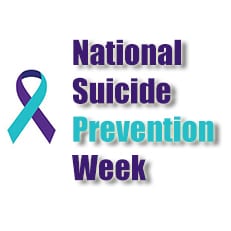A recent report from the Center for Disease Control stated that from 1999 – 2016 suicide rates increased in every state except Nevada, which had a very minor decrease. The report also found the highest suicide rate in Montana. Most alarming is that suicide deaths for Americans total approximately 45,000 every year, increasing for virtually every age group, race and gender.
Suicide Prevention Week is designed to raise awareness of the warning signs of suicide, promote prevention resources, and to encourage Americans to talk more about suicide prevention. Broaching the subject of suicide with someone will not cause them to think about ending their life. However, if they are suicidal, it gives them a chance to unburden themselves and to know that help is available.
One question most people ask are what are the most common warning signs of suicide. In general, the warning signs include:
- Statements about suicide, death and dying;
- Giving away of prized possessions;
- Dramatic changes in behavior;
- Making out a will
Suicide is most often the result of mental illness such as depression. There are evidence based treatments for all mental illnesses.
Americans also need to know the importance of means restriction. I would like to share this recent example.
My cousin called me to share that his neighbor Bob, who has been depressed, was seen in the parking lot of his condominium holding a gun to his head. I asked if anyone had immediately taken his neighbor to an emergency room and the answer was no. My cousin said Bob suffered from advanced stages of Parkinson’s disease. I asked my cousin if Bob was receiving any mental health treatment in addition to the medical treatment for his Parkinson’s disease. My cousin responded that Bob was not receiving mental health treatment. Stating that it was unfortunate Bob had not been taken to the emergency room when he was suicidal, I asked if all guns had been removed from his home. My cousin reported that Bob’s wife told him that the guns belonged to her husband and she did not have the right to remove them. My cousin asked, “what difference would it make if the guns were removed as Bob would find another way to die by suicide.”
I shared with him the research that when you remove the lethal means, such as a gun or raise the barrier on a bridge to inhibit people from jumping, that suicide rates go down. My cousin asked what he could do to help his friend Bob. I responded that Bob’s physician needed to know about his depression and suicidal actions and it was necessary to remove the guns from his home.
I’m pleased to report that Bob is now receiving the needed mental health treatment, guns have been removed from his home and he knows how to contact suicide prevention resources. I share this example to illustrate that suicide can be prevented.
I recently wrote the Crisis Action School Toolkit on Suicide for the state of Montana. Suicide is the leading cause of death for adolescents in Montana and it is my hope that a future generation of Montanans will know how to prevent suicide.
Everyone needs to know the 24 hour National Crisis Helpline. The numbers are 1-800-273-TALK, 1-800-Suicide, and the National Crisis Text line can be accessed by texting HOME to 741741.
 Dr. Scott Poland lost his father to suicide and is a professor in the College of Psychology and the Co-director of the Suicide and Violence Prevention Office at Nova Southeastern University www.nova.edu/suicideprevention
Dr. Scott Poland lost his father to suicide and is a professor in the College of Psychology and the Co-director of the Suicide and Violence Prevention Office at Nova Southeastern University www.nova.edu/suicideprevention
Nova Southeastern University fully supports an individual’s right to express their viewpoint and opinions. The views expressed in this guest editorial are that of Scott Poland, Ed.D., in Nova Southeastern University’s College of Psychology and are not necessarily those of NSU, its President or Board of Trustees.

